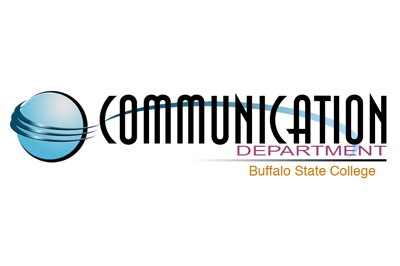| Location |
| Bishop Hall 1300 Elmwood Avenue, Buffalo, NY 14222 |
| Phone |
| Voice (716) 878-6008 |
| Fax (716) 878-4697 |
| [email protected] |
| Website |
| Communication Department |
| Department Chair |
| Ron Smith |
| Faculty & Staff of the Communication Department |
One of the most celebrated aspects of Buffalo State’s communication department has been the high level of professional experience and diversity held by faculty and staff. There are approximately 15 full-time faculty members, all of whom held various positions as news editors, reporters, PR specialists, photographers etc., as well as over 30 part timers who currently work within the communications field. Some of the more notable part timers being Brian Meyer and Mary Pasciak, both reporters for the Buffalo News, Margaret Sullivan, editor of the Buffalo News, and Mike Igoe, Channel 2 television anchor.
| Mission & Vision of the Communication Department |
The Communication Department at Buffalo State College is a faculty of scholars who service the communication disciplines, by creating new information, and sharing existing information, within a community of communication and media production professionals. It is also a faculty of educators who strive to prepare students in the respected communication or media production disciplines, to critically think, incorporate creativity in their fields of interest, communicate effectively and act with dignity to succeed in their careers.
Core Values As a collegial and determined group of faculty and staff, both individually and together, work toward the success of the Communication Department mission, therefore holds to the following values:
Service Excellence: In relationship to students, the Communication Department’s faculty and staff believes in upholding the best practices of service excellent, giving precedence to each independent students needs in matters such as class scheduling, advisement, tutoring etc.
Quality Performance: In relationship to employees and graduate schools, the Communication Department believes in upholding the best practices of quality performance, by giving great concern in matters of setting and maintaining high professional standards, and increasing graduate ratings of graduates who excels in respected careers.
Social Responsibility: In relationship to employees, students, and community, the Communication Department believes in upholding the best practices of social responsibility, by offering leadership opportunities, internships, and scholarships, to people who service the communication and media production disciples.
Academic Excellence: In relationship with higher education- at Buffalo State College State University of New York and all other institutions, the Communication Department believes in upholding the best practices of academic excellence, providing students the opportunities to think analytically, solve problems using creativity, and understanding communication in a manner, that will help students excel in respected careers.
| Vision |
The Buffalo State College State University of New York’s Communication Department will continue to provide an all-inclusive variety of communication courses that are consistent with the mission and core values, to ensure student success in the communication and the media production professions.
| Undergraduate Majors |
Public Communication At Buffalo State College public communication has been listed amongst the top-rated programs of its kind; the only public communication major, in the SUNY system, which does not separate advertisings and public relations. This major allows students flexibility in creating a program, from an array of communication course choices. As one of the most challenging programs at Buffalo State, it is the only major in the communication department with a graduate program. Public Communication is nationally accredited by the Accrediting Council for Education in Journalism and Mass Communications.
Communication Studies As a liberal arts based major, the communication studies program at Buffalo State College provides students the opportunity to study communication from both a theoretical and an applied perspective. Choosing from a wide array of courses in writing, oral communication, visual communication and theory, students can tailor their programs to meet their own needs and interests. This major typically prepares students for careers in research, organizational communication, law, and other professional areas requiring a communication background.
Journalism The journalism major is a professional degree program emphasizing newsgathering, news analysis, and news writing/reporting throughout the various forms of media. Two areas of specialization are offered (1. Print and 2. Broadcast) in which students follow a specific sequence of courses relevant to their respective concentrations. It should be noted however, that students can still take any other COM course (in the form of an elective) should they show interest in it.
Media Production The media production major is also a professional degree program focusing mainly on the technical aspects of media such as audio/radio, video/television, and digital/internet media. Courses integrate many of the main elements of electronic media and emphasize media convergence, digital applications, and new forms of media distribution. This major is not to be confused with the Broadcast Journalism major, which contains much more of a written component than this major.
Television Arts The television and film arts (TFA) major at Buffalo State College is an interdisciplinary program, with a combination of Communication, English and Theater Departments, which prepares students for a variety of skills in the field of interest. The program is very competitive, only accepting (15- students a year) and there is an application process. Students will learn to write, direct, produce, edit videos, and are introduced to set design.
| Minor |
Speech The speech minor involves six courses, within the Communication Department. It is designed for students with majors in which oral communication plays and important part in their career. Please be advised communication majors who are apart of programs such as Public Communication, Communication Studies, Television Arts, Media Production, and Journalism, cannot minor in speech and Buffalo State College. This is because the Communication Department already included into such programs, that oral communication plays an essential part in the communication and media production careers.
| Accreditation |
Accreditation: In May of 2010, Buffalo State College became the first SUNY school and NY public institution to receive full accreditation from the Accrediting Council for Education in Journalism & Mass Communication (ACEJMC), the official body evaluating professional programs for students in communications related fields. While almost all professional Communication programs in the country have some type of accreditation, the ACEJMC accreditation has only been granted to roughly 15% of such programs. As a result, certain departmental standards have been raised to keep in compliance with ACEJMC standards. Most notably being: minimum grades (the lowest acceptable grade for a course is a C), non-com courses (at students must have at least 80 credits without the COM prefix), and maximum transfer credits ( only 12 credits of lower division courses from community colleges are accepted). There are also several other non-academic standards dealing with governance, diversity, and faculty scholarship/research that the department must keep in compliance with. Having this accreditation not only benefits the department, which boosts their image, but it also benefits the students in that their degree will carry more weight.
| Department History |
The Communication Department started off in the early 1970s, when the Speech and Theater Arts Department added TV broadcasting, and radio to the set of courses. The Public Communication major was added to the department in 1987, at that time the Journalism and Broadcasting majors were created. The department was renamed the Communication Department in 1989. In the late 1990s the Communication department received their first computer lab in the basement of Bishop Hall. Today the Communication Department has more than 500 majors; it is the fifth largest department in the College’s School of Arts and Humanities and the largest Communication throughout the SUNY system.  A photo by Sametratoe
A photo by Sametratoe
| National Communication Honors Society |
Lambda Pi Eta Student Honor Society Rho Psi Chapter at Buffalo State College, was charted in 2005, and is the 40th active chapter worldwide. Eligibility: student must have an overall GPA of a 3.0 or higher and a 3.25 major GPA. The honor society was created to honor students with scholastic, academic excellence.
| Multimedia Sites: Where you can learn more about the Buffalo State College Communication Department |
| ComBlog |
| Join Communication Department: Buffalo State College Group |
| Student Media Showcase |
| Communication YouTube |



